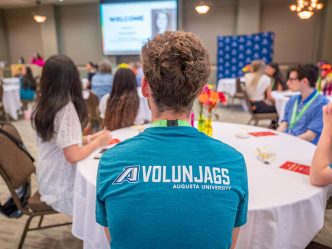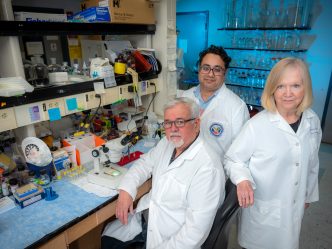AUGUSTA, Ga. – The trick to making Halloween a treat is being prepared, experts say.
“The number one rule is plan, plan, plan,” says Carla Allen, a senior staff nurse in the Neonatal Intensive Care Unit at Children’s Hospital of Georgia and an instructor with Safe Kids Greater Augusta, a CHOG-led program. “Have a plan for before, during and after trick-or-treating to keep your kids safe.”
Below are six tips to making sure little goblins have fun and avoid danger:
1. Plan your child’s costume.
“Face paint is better than a mask, because masks can make it hard for children to see and could decrease their peripheral vision,” Allen said. Parents should also choose costumes that are flame-retardant, especially if the costume has loose-fitting parts like wigs, cloaks and skirts, which can end up flowing into a live jack-o-lantern flame.
“Shoes should be sturdy,” Allen said. “While little princesses love high heels, they can be unsteady on uneven ground or grass. Save those for picture time.” It’s also a good idea to have shoes with thick soles so that anything children step on doesn’t pierce their feet.
Accessories should be made of soft, flexible material so that if your children fall, they’re not impaled. “Make a sword from cardboard and cover the “blade” with foil,” she said. “Even fairy wands can be quite sharp. Make a homemade alternative from glitter paint and cardboard.”
Incorporate reflective materials. Parents can use reflective tape or attach reflectors and glow sticks to a costume belt or treat bag for example.
2. Plan for a snack.
“Children who are hungry when they go out trick-or-treating are likely to sample candy before their parents have a chance to inspect it,” Allen said. Make sure children know that their candy must be inspected by their parents before they eat it, and that homemade treats are off limits.
3. Plan the route.
If you’re not accompanying a child older than 12, plan his or her route ahead of time, and go over it with them. Minimize the need to cross the street, other than at street corners and in well-lighted areas. It’s also a good idea to enforce a buddy system and provide older children with a cell phone to call home if needed.
“Children have the cognitive skills to be independent pedestrians by the time they’re 10,” Allen said. “But on Halloween, with the added excitement and increased risks, it’s a good idea to chaperone them.”
4. Plan and set the ground rules.
“Instruct your children to never enter anyone’s home, including people they may know,” Allen said. “It’s also a good idea to explain that homes without the lights on are not just trying to appear scary for Halloween. Make sure they know those homes are off limits.”
5. Candy-givers should plan, too.
Even if you don’t have a trick-or-treater at home, you should have a plan.
“If you’re giving out candy, clear your yard of obstacles like rakes and hoses that can be tripping hazards for children,” she said. “Think like a child. A child will not walk on a pathway necessarily. They’re looking for the shortest route to your front door, and that may be directly across the front yard.”
Experts also recommend changing the way you carve your pumpkin. Carving a hole at the bottom and using inexpensive battery-powered lights instead of live flames is a safer option. If you do choose the traditional candle to light your pumpkin, a hole at the bottom also eliminates the need to reach into the pumpkin to light it.
6. Drivers should plan for pedestrians.
Watch for increased foot traffic. It’s a good idea to drive under the speed limit. “Children will come out of places you don’t expect,” Allen said. Statistics show that pedestrian accidents increase dramatically on Halloween.
“Be overly vigilant in planning for the safety of young ones,” she says, “because everyone doesn’t prepare like you do.”
The 154-bed not-for-profit Children’s Hospital of Georgia is the second-largest children’s hospital in the state, providing the highest level of pediatric critical care and neonatal intensive care, as well as a wide range of general and complex health care for children. CHOG was recently ranked as the nation’s top-performing children’s hospital in quality and safety.
Safe Kids Greater Augusta, led by Children’s Hospital of Georgia, works to prevent accidental childhood injury, the leading killer of children ages 1 to 14. Safe Kids Greater Augusta is a member of the Safe Kids Worldwide and USA networks. To find out more about local Safe Kids programs, call 706-721-7606, or visit grhealth.org/safekids.
Media Inquiries:
Denise Parrish
Senior Media Relations Coordinator
706-721-9566 Office
706-831-3148 Cell
mparrish@gru.edu
 Augusta University
Augusta University





